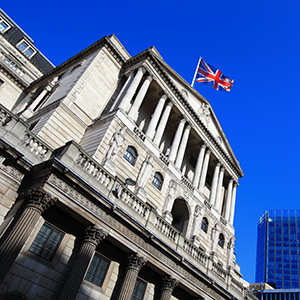Trickle or Treat - What do last week’s announcements mean for the economy and commercial real estate?

On Friday, the Chancellor announced his plan to boost economic growth to Parliament and began with the assurance that the independence of the Bank of England was “sacrosanct”. This reveals the concerns high in the minds of government and the markets, particularly regarding the impact of the new spending plan on inflation and the value of the pound.
Much of the measures announced had been publicised ahead of last week’s fiscal event, but sharp falls in the pound, the equity markets and in government bonds following the Chancellor’s statement suggest markets were taken aback by the sheer size and the potential implications of the overall package. During the Summer the new Prime Minister had pledged to review the mandate of the Bank of England. Given the significant increase in borrowing the government has embarked on, the Chancellor wanted to reassure investors about the currency and the fight against inflation.
The Chancellor’s measures can be broadly broken into four categories –
1. Those, like the energy price cap, that will lessen the economic hit which is already underway. While limiting further increases is a positive step, consumers and businesses will still face energy bills in some case double the level of last year even with the new measures.
2. Those that remove an upcoming policy that would have slowed growth further, such as cancelling the plan to lift Corporation Tax from 19% to 25%. Nevertheless, this move will not stimulate additional growth, just prevent another brake being applied.
3. New measures that could generate a new wave of growth, such as the reversal of the National Insurance hike, axing of the 45% income tax rate, bringing forward cutting the basic rate to 19%, the new Stamp Duty Land Tax (SDLT) regime, and ending the bankers’ bonus cap.
4. Broadening the scope of (or pushing harder on) existing initiatives. This includes more pledges to speed up the planning process, releasing government land for house building, and Investment Zones - an expansion of sorts of the existing enterprise zone policy.
On face value, there is a large package of measures here to assist households and businesses through the cost-of-living crisis (but not enough to stave it off entirely). The reversal of the National Insurance rise, which is implemented in November, will provide some near-term stimulus to the economy. The Bank of England (BoE) said at its Thursday meeting that it expects the energy cap to result in a lower peak for inflation than previously anticipated, at 11%. However, BoE also raised the base rate 50 bps, announced £80 billion of Quantitative Tightening, and gave a strong hint that if the fiscal stimulus from the Chancellor proves to be inflationary, rates will rise again.
Government bonds, which are very sensitive to interest rates, fell in value after the statement, with 10-year gilt yields rising over 25 bps in early trading, taking the increase last week to more than 50 bps. Equity markets also fell sharply immediately after the Chancellor’s statement. Markets are clearly viewing the package of measures as inflationary and expect that the BoE will have to raise rates further in response.
This brings us back to the Chancellor beginning his speech by trying to reassure the financial markets. So far in 2022, the pound has fallen 18% against the US dollar, while 10-year Gilt yields have risen 270 bps – which highlights growing concern over the UK government’s finances and growth prospects. To this backdrop, there is the risk we now have the government and BoE pulling in different directions – with the former trying to boost growth, and the latter trying to moderate it in order to bring down inflation.
What’s in it for real estate?
Commercial property does best when the economy is expanding, so measures to boost growth are generally a good thing for the sector. However, Friday saw tumbles in value for the pound and government bonds, which suggests the Chancellor’s plan has not been immediately well received by the financial markets. A general tone of caution on the outlook for the UK economy as a whole will impact near-term prospects for the commercial property market and may dampen sentiment.
The steps announced by the Chancellor will lessen the impact of the UK economic downturn which we believe is already happening and which we expect to last through the first half of next year. We are predicting that commercial property yields will soften throughout this period, not least because of the dramatic increase in risk-free rates and borrowing costs in recent months. Defensive real estate assets expected to hold up best will be prime and buildings with strong ESG credentials.
However, we also believe the weakness of sterling will entice in foreign (particularly North American) capital. Consequently, H2 2023 may mark a potential turning point for the investment market. Recovery for occupier markets may come later as consumers start to feel more benefit from the tax cuts announced in this mini-budget, and companies utilise the pro-enterprise measures. Both firms and households will gain from the steady decline in inflation that is expected to be seen next year. Our forecast is for the occupier market to move into a new cycle in winter 2023/2024.
The mini-budget was quiet on business rates beyond the reference to a potential 100% rates to be applied within new Investment Zones. Nevertheless, we expect a number of announcements over the next 2-3 months. Undoubtedly there are genuine risks with rising inflation connected to the 2023 rating revaluation and the interplay with the uniform business rate. We should see a significant redistribution of the tax base away from retail and hospitality to logistics and light manufacturing. How the government will manage this redistribution without damaging the worst affected businesses will not be known until December.
Given the growing importance of the ESG agenda to the property world, it was encouraging to see the government working to remove planning barriers to new infrastructure projects. This is also a reminder that the switch to a carbon neutral world will be a major source of growth and jobs in the coming years.
The announcements on the 38 Investment Zones offer potential medium-term benefits, but they have been tried many times before and the evidence for their success is very mixed. We will need to see more detail on the Investment Zones to offer an informed view on whether they present an impactful initiative for locations looking to pitch for inward investment.
Turning to residential property, the sum of money the SDLT cut will save buyers will be counterbalanced by rising interest rates in the near-term pushing up mortgage repayment costs. The biggest savings are for first time buyers in London and the South East, as most first time buyers in other regions were not paying stamp duty under the previous regime. They also face the end of the ‘Help to Buy’ scheme which has supported around 40,000 transactions a year over the last five years and helped many overcome the obstacle of saving for a deposit. While the SDLT cut will boost the market in the medium- to long-term, house price growth has been slowing for several months now, and we expect this to continue over the next six months.
Final thoughts
The Truss government has certainly hit the ground running, and if all the energy price measures are included, we have seen a major package of fiscal measures this month. We do believe this will eventually help boost growth, but at a price that runs the risk of conversely weighing on the economy over the long-term through a larger debt burden. Short-term, these measures could well prove to be inflationary, at least in the eyes of the MPC, leading to “higher for longer” interest rates over the next few of years. This coupled with a weaker economy will have an inevitable impact on the real estate investment market, impacting values and, more immediately, risking a reduction in the volume of transactions. Much will now depend on how much growth this mini-budget truly does generate and whether the ‘Laffer Curve’ – an economic theory which argues lower tax rates can lead to higher tax revenues – really is correct.


